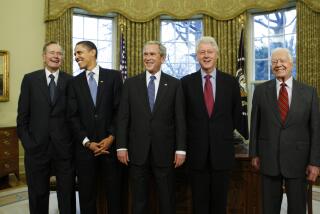Continuity When It Counts
- Share via
Continuity of leadership has never been so crucial as in the nuclear age when an adversary might be tempted to test American will during a period of confusion, illness, stress or mourning.
In such times, the nation is fortunate to have a President of remarkable physical vigor for his 74 years. President Reagan’s general good health led to a speedy recovery from a would-be assassin’s bullet in 1981 and, now, it appears, is leading to a similar recovery from major surgery to remove a growth from his colon. The nation wishes him a comfortable recuperation, free from complications.
The nation is fortunate, as well, to have a Constitution that allows it to conduct its affairs without interruption in the event of presidential disability--the 25th Amendment to the Constitution, ratified in 1967. While the White House curiously avoided direct triggering of Section 3 of the amendment, constitutional scholars seem to agree that it was indeed invoked by the President’s letters to Capitol Hill on Saturday. For nearly eight hours, Vice President George Bush carried the full powers of the presidency as acting President, the first person in the 198 years of the Constitution to formally hold this position.
As we know now, the 25th Amendment should have been invoked at the time of President Reagan’s gunshot wound, although the President was incapable of signing the requisite letter at the time of the emergency. That could have been done, however, by the vice president and members of the Cabinet under Section 4 of the amendment which still has not been utilized.
Regardless of the White House’s qualification, important constitutional history was made Saturday. Section 3 of the 25th Amendment appropriately was utilized for the first time to assure Americans of the integrity of the most vital function of government today--the continuity of presidential command.
More to Read
Get the L.A. Times Politics newsletter
Deeply reported insights into legislation, politics and policy from Sacramento, Washington and beyond. In your inbox twice per week.
You may occasionally receive promotional content from the Los Angeles Times.










